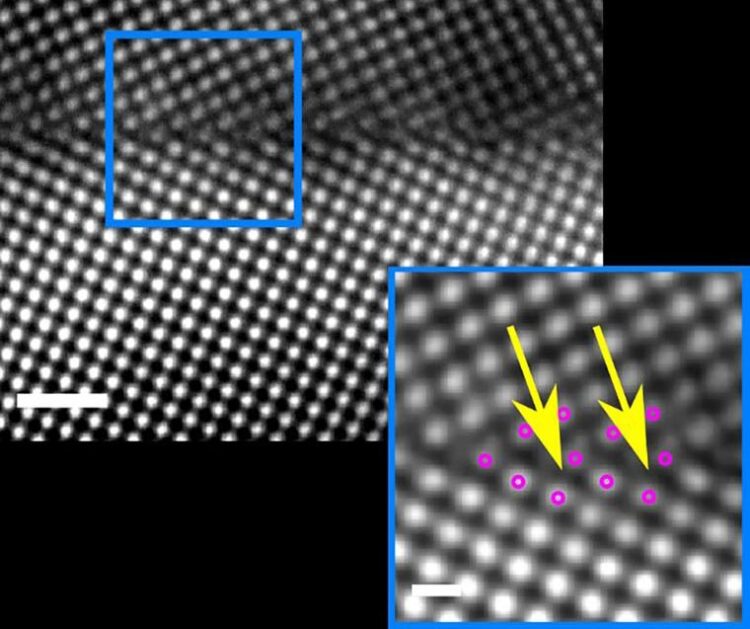Small, but powerful: How impurities effect grain boundary segregation

The image reveals a kite-type structural arrangement of the atoms at the ∑5 (310) [001] grain boundary.
Image taken from Nature Communications 12 (2021) 6008
Iron (Fe) is known and utilized by mankind since thousands of years, but until now, we know very little about the local chemistry at the interfaces separating different crystallites, so-called grain boundaries. Beyond that, how different solute species interact remains elusive. What happens when two or more elements diffuse to the grain boundary and segregate there? How do they interact with each other and how will they influence the interfacial properties?
Ali Ahmadian, researcher in the department Structure and Nano-/Micromechanics of Materials headed by Prof. Dehm at the Max-Planck-Institut für Eisenforschung (MPIE), and his colleagues analysed the underlying processes of co-segregation effects in bcc-iron grain boundaries. They focussed on the effects of carbon and boron, which are typical impurities present in nearly all technologically relevant materials, and published their latest results in the journal Nature Communications.
Impurities could be the reason for failure of grain boundaries
The researcher team combined scanning transmission electron microscopy, energy dispersive spectroscopy and atom probe tomography to observe the atomic structure and local composition of the ∑5 (310) [001] grain boundary. They correlated their experimental observations with first-principle density functional theory calculations performed by partners at the Materials Center Leoben (Austria) to elucidate the underlying segregation mechanisms. “We found out that the atoms arrange themselves in form of a kite-type motif at the grain boundary, which repeats itself along the interface. Surprisingly, our experiments regarding the composition of the grain boundary suggested that aluminium is depleted instead of enriched – that was quite the opposite of previous theoretical studies.”, explains Ahmadian.
The scientists observed and simulated how carbon and boron impurities segregated to the grain boundary and repelled aluminium. “Our findings could offer a new perspective into why grain boundaries fail in certain materials or may even provide pathways to mitigate the segregation of detrimental elements to prevent failure. With our modelling tools at hand we may in the future even make predictions on grain boundary segregation and interface properties to guide material design routes. This is absolutely necessary for the development of high-performance materials.”, says Dr. Christian Liebscher, head of the group “Advanced Transmission Electron Microscopy” where Ahmadian works in.
Future research on zinc impurities
The MPIE scientists and their colleagues are now aiming to apply their results to more complex material systems. A special focus lies on zinc, which is responsible for liquid metal embrittlement leading to catastrophic material failure in many iron-based alloys and steels. The ultimate goal is to find alloying or processing concepts that mitigate the effect of zinc on grain boundaries.
The research was partly funded by the Austrian Research Funding Association and the Austrian Federal states of Styria, Upper Austria and Tyrol.
Wissenschaftliche Ansprechpartner:
Ali Ahmadian, a.ahmadian@mpie.de
Originalpublikation:
A. Ahmadian, D. Schreiber, X. Zhou, B. Gault, C.H. Liebscher, L. Romaner, G. Dehm: Aluminum depletion induced by co-segregation of carbon and boron in a bcc-iron grain boundary. In: Nature Communications 12 (2021) 6008. DOI s41467-021-26197-9
Weitere Informationen:
https://www.mpie.de/4633439/how-impurities-effect-grain-boundary-segregation
Media Contact
All latest news from the category: Machine Engineering
Machine engineering is one of Germany’s key industries. The importance of this segment has led to the creation of new university degree programs in fields such as production and logistics, process engineering, vehicle/automotive engineering, production engineering and aerospace engineering among others.
innovations-report offers informative reports and articles covering technologies such as automation, motion, power train, energy, conveyor, plastics, lightweight construction, logistics/warehousing, measurement systems, machine tools and control engineering.
Newest articles

Decoding Cancer: 40 Years of Breakthroughs in Genetic Research
Cancer in children and adolescents is rare. Nevertheless, malignant diseases are still one of the most common causes of death in this age group. Survivors of childhood or adolescent cancer…

Let’s Think Before the First Drink: How Early Substance Use Might Lead to Brain Structure Differences Among Adolescents
Many differences appeared to exist prior to any substance use, pointing to the role brain structure may play in substance use risk, NIH-supported study suggests. Studies reveal factors that expose…

Combating Kidney Cancer Using Enhanced Immunotherapies
Medical University of South Carolina Hollings Cancer Center researcher receives Department of Defense Early Career Scholar Award to improve immune therapies by targeting resistant kidney tumors. A Medical University of…



